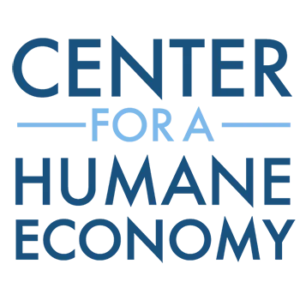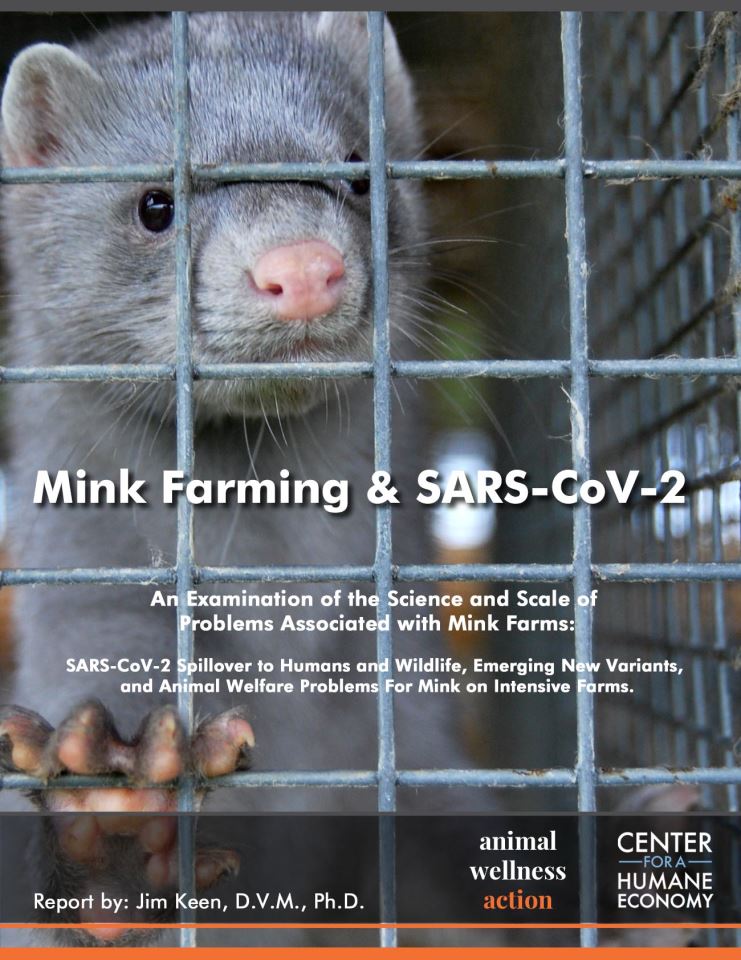Center for a Humane Economy Releases Scientific Report Revealing How Intensive Mink Farms May Incubate New Virus and Also Threaten Animal Welfare and Wildlife Health
(Washington, D.C.) – High-ranking U.S. House lawmakers, led by Appropriations Chairwoman Rosa DeLauro, D-Conn., and U.S. Rep. Nancy Mace, R-S.C., introduced legislation to ban mink farming, working with Animal Wellness Action, the Center for a Humane Economy, and the Michelson Center for Public Policy on legislation motivated by concerns about the role of these mink farms in spreading SARS-CoV-2. Underpinning the “Minks in Narrowly Kept Spaces Are Superspreaders Act (MINKS Act)” is an extensive scientific report and analysis of the risks posed by mink farms to public health, native wildlife populations, and U.S. ecosystems.
In addition to DeLauro and Mace, Reps. Peter DeFazio, D-Oregon, Michael McCaul, R-Texas, Raul Grijalva, D-Ariz., Claudia Tenney, R-N.Y., Jan Schakowsky, D-Ill., D-Fla., Lance Gooden, R-Texas, Veronica Escobar, D-Texas, and David Valadao, R-Calif., are co-authors of the first-ever national legislation to ban mink farming. Just months ago, Denmark killed 17 million mink after farms there spawned a Cluster-5 variant that infected thousands of Danes, while the Netherlands eliminated four million after farms turned into super-spreaders.
The U.S. legislation amends the Lacey Act to forbid possession, sale, and trade in captive American mink (Neovison vison) or their parts. Mink farmers would be allowed to pelt out their remaining animals but not to resume additional breeding and production of the animals for fur. Zoos and research facilities are exempt, and there would be no restrictions on the trade in native wild mink, who are much smaller than the captive-bred mink.
The factory farming of mink threatens public health, especially as we continue fighting against the COVID-19 pandemic,” said Congresswoman Rosa DeLauro, who also chairs the appropriations subcommittee that overseeing funding for a large portion of U.S. medical research. “The evidence is clear: mink operations can incubate and spread new COVID-19 variants, and pose a unique threat of extending the pandemic. At the same time, with virtually no domestic market, the U.S. mink industry has been in steady decline for years. Now is the time for this legislation to become law, and I am urging all of my colleagues to support this bipartisan effort.”
In the U.S. it appears that more than 20 percent of U.S.’s 60 to 80 active fur farms have had infections, with a Michigan fur farm spawning a variant. That was the third SARS-CoV-2 variant to come from a mink farm (France had the third novel variant).
“The farming of Mink used for fur production is inhumane,” Congresswoman Mace said. “This practice is not only an animal welfare concern, but a public health one too. America has suffered enough throughout this pandemic, and there is no need to continue an abusive animal practice that puts American’s health at risk through the mink’s high susceptibility to COVID-19.”
“If SARS-CoV-2 could design its perfect habitat, it might closely resemble a mink ranch: a highly stressed, immuno-suppressed inbred host with thousands of other mink kept in very small cages,” said Dr. James Keen, D.V.M, Ph.D. (epidemiology), director of veterinary science for the Center for a Humane Economy and a global expert on animal-borne infectious diseases. “This environment maximizes chances for infections and mutations.”
According to the report from Dr. Keen, mink pose unique public health risks from SARS-CoV-2: 1) Mink are the only animals beside people that transmit, become sick, and die in large numbers from COVID-19; 2) Mink are the only animals besides people that transmit the COVID-19 virus back to people often in mutated form. Mink farmers, their families and their communities are at greatest risk; 3) Mink are the only animal with a large potential wild animal reservoir for COVID (i.e. the millions of wild or feral mink in the Northern hemisphere, some of which have already been infected; 4) Mink are a top candidate as the “missing link” between bats which most scientists believe to be the original source of COVID, and people according to the World Health Organization; 5) Mink are a proven source of multiple novel virus variants that may compromise human vaccine effectiveness or increase human virus virulence or transmissibility; 6) U.S. mink veterinary vaccines against COVID-19, which are still in development, are no panacea and may even be detrimental to control of the COVID-19 pandemic.
Escaped captive mink can outcompete native wild mink given that they are twice their size. They can also infect wild populations, creating an ineradicable source of SARS-CoV-2 in North America, just as rabies, plague, and brucellosis have taken permanent hold in wildlife populations in the U.S. The presence of SARS-CoV-2 in wild mink means that there is an indefinite threat of mutation and viral spillover back to humans.
“SARS-CoV-2 likely got its launch at a live-wildlife market in China even after warning from animal welfare advocates and infectious disease specialists that these commercial trading posts could spawn the next epidemic or pandemic,” said Wayne Pacelle, president of Animal Wellness Action. “We know that mink are the only non-human animals who are bilateral transmitters of COVID-19, and yet we continue to house them on factory farms to generate a luxury product that few people want or need.”
“Preventing zoonotic diseases from spreading within our country is vital to protect the health and safety of the American public,” said Mike McCaul, the Republican leader of the Foreign Affairs Committee. “The MINKS Act will not only ensure we stop spreads of SARS like viruses, but also stop the inhumane practices of mink farms.”
“For decades, wild animals like minks have been held captive and confined in cages for fur production,” said Congresswoman Escobar. “Not only does this cruel practice cause animals to suffer, but it also creates immense human health concerns as science has shown that minks are highly susceptible to COVID-19 and put fur workers at risk. I’m proud to join Congresswoman DeLauro in introducing the MINKS Act to put an end to animal cruelty and regulate the fur industry.”
“If COVID-19 spreads from farmed mink into the large wild and feral mink populations across the northern hemisphere, humans may be cursed with COVID-19 risk forever,” noted Gary Michelson, M.D., founder of the Michelson Center for Public Policy, based in California.
In 2019, USDA reported gross revenues of $59 million for U.S.-based mink farms, with the production of 2.7 million mink. Before the virus, there were 60 million mink produced in the world, with the top producers being Denmark, China, Poland, the Netherlands, and Russia. U.S. mink production amounted to 5 percent of the global total, with U.S. demand just slightly more than zero. Just this week, Canada Goose and Neiman Marcus announced that they are ceasing any fur sales soon, joining dozens of other major fashion and clothing retailers in making this commitment.



